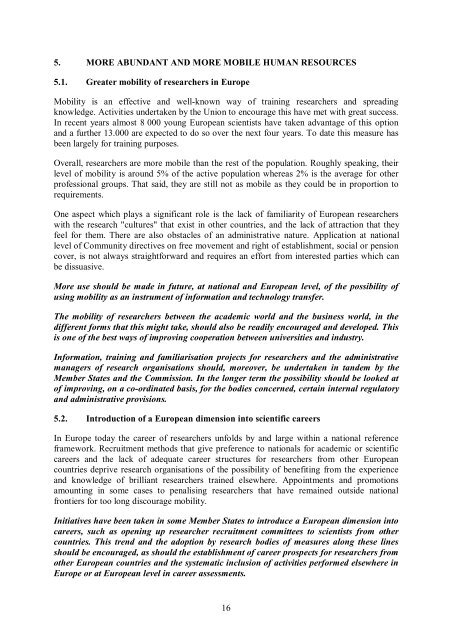(2000) 6 - EUR-Lex
(2000) 6 - EUR-Lex
(2000) 6 - EUR-Lex
You also want an ePaper? Increase the reach of your titles
YUMPU automatically turns print PDFs into web optimized ePapers that Google loves.
5. MORE ABUNDANT AND MORE MOBILE HUMAN RESOURCES5.1. Greater mobility of researchers in EuropeMobility is an effective and well-known way of training researchers and spreadingknowledge. Activities undertaken by the Union to encourage this have met with great success.In recent years almost 8 000 young European scientists have taken advantage of this optionand a further 13.000 are expected to do so over the next four years. To date this measure hasbeen largely for training purposes.Overall, researchers are more mobile than the rest of the population. Roughly speaking, theirlevel of mobility is around 5% of the active population whereas 2% is the average for otherprofessional groups. That said, they are still not as mobile as they could be in proportion torequirements.One aspect which plays a significant role is the lack of familiarity of European researcherswith the research "cultures" that exist in other countries, and the lack of attraction that theyfeel for them. There are also obstacles of an administrative nature. Application at nationallevel of Community directives on free movement and right of establishment, social or pensioncover, is not always straightforward and requires an effort from interested parties which canbe dissuasive.More use should be made in future, at national and European level, of the possibility ofusing mobility as an instrument of information and technology transfer.The mobility of researchers between the academic world and the business world, in thedifferent forms that this might take, should also be readily encouraged and developed. Thisis one of the best ways of improving cooperation between universities and industry.Information, training and familiarisation projects for researchers and the administrativemanagers of research organisations should, moreover, be undertaken in tandem by theMember States and the Commission. In the longer term the possibility should be looked atof improving, on a co-ordinated basis, for the bodies concerned, certain internal regulatoryand administrative provisions.5.2. Introduction of a European dimension into scientific careersIn Europe today the career of researchers unfolds by and large within a national referenceframework. Recruitment methods that give preference to nationals for academic or scientificcareers and the lack of adequate career structures for researchers from other Europeancountries deprive research organisations of the possibility of benefiting from the experienceand knowledge of brilliant researchers trained elsewhere. Appointments and promotionsamounting in some cases to penalising researchers that have remained outside nationalfrontiers for too long discourage mobility.Initiatives have been taken in some Member States to introduce a European dimension intocareers, such as opening up researcher recruitment committees to scientists from othercountries. This trend and the adoption by research bodies of measures along these linesshould be encouraged, as should the establishment of career prospects for researchers fromother European countries and the systematic inclusion of activities performed elsewhere inEurope or at European level in career assessments.16
















